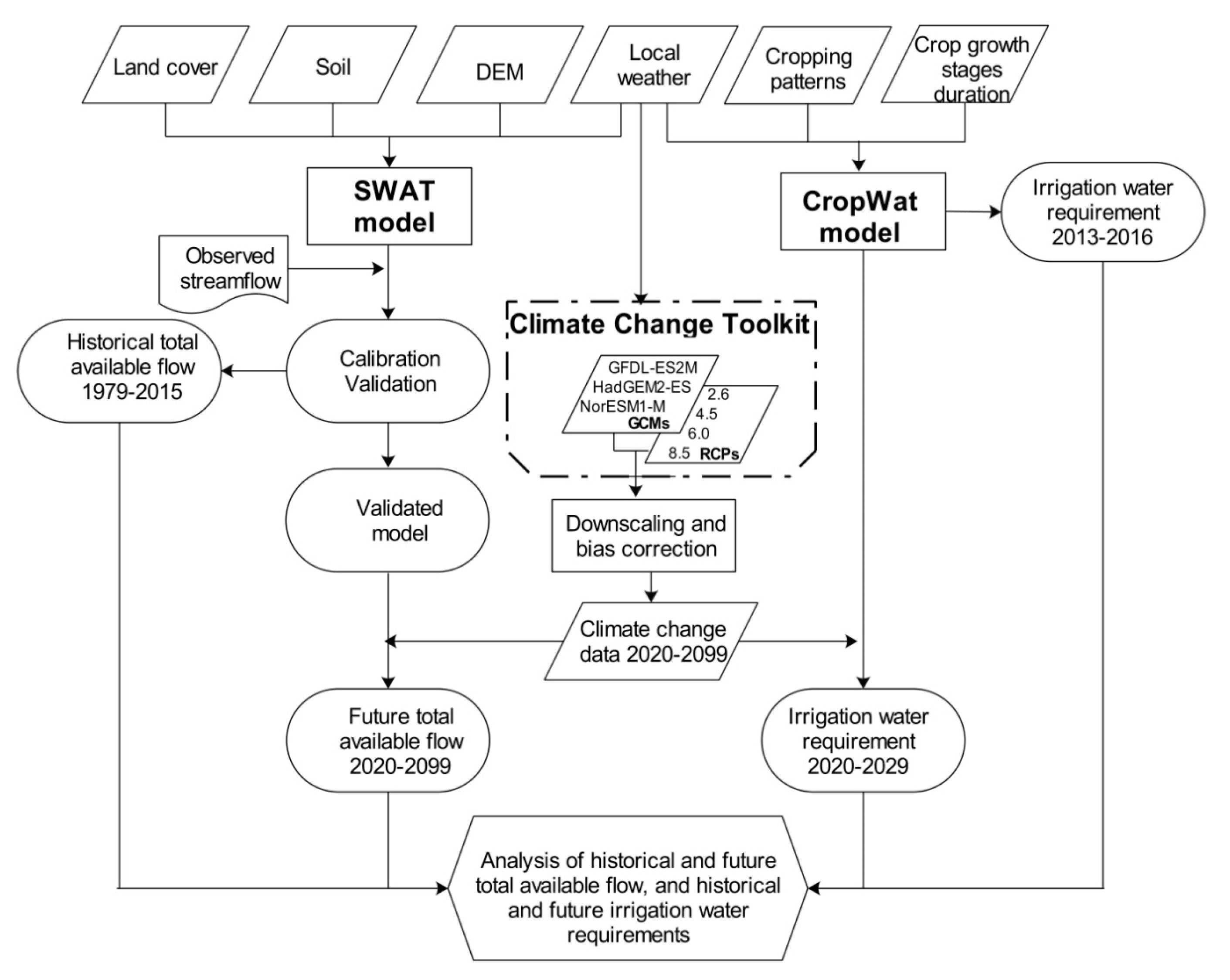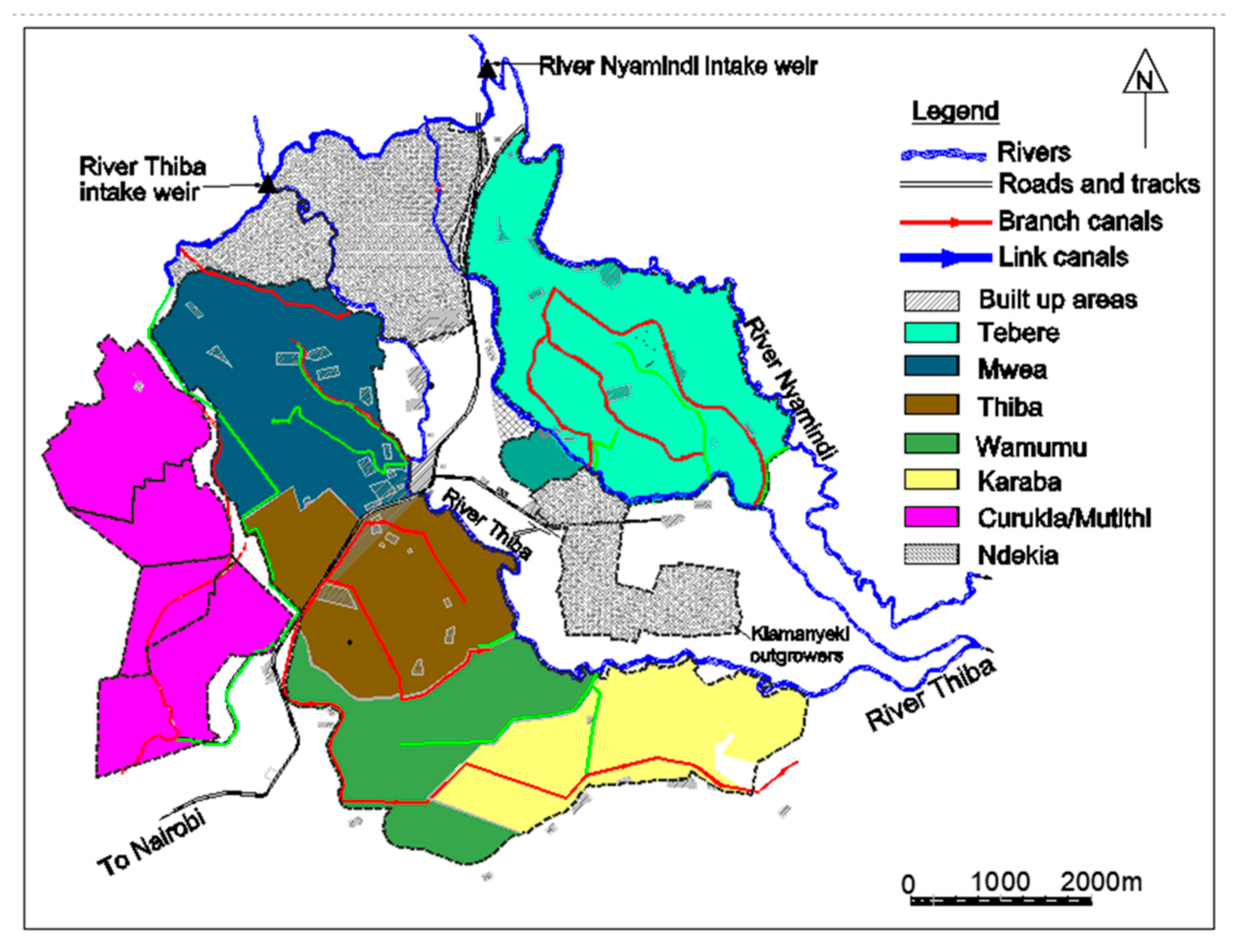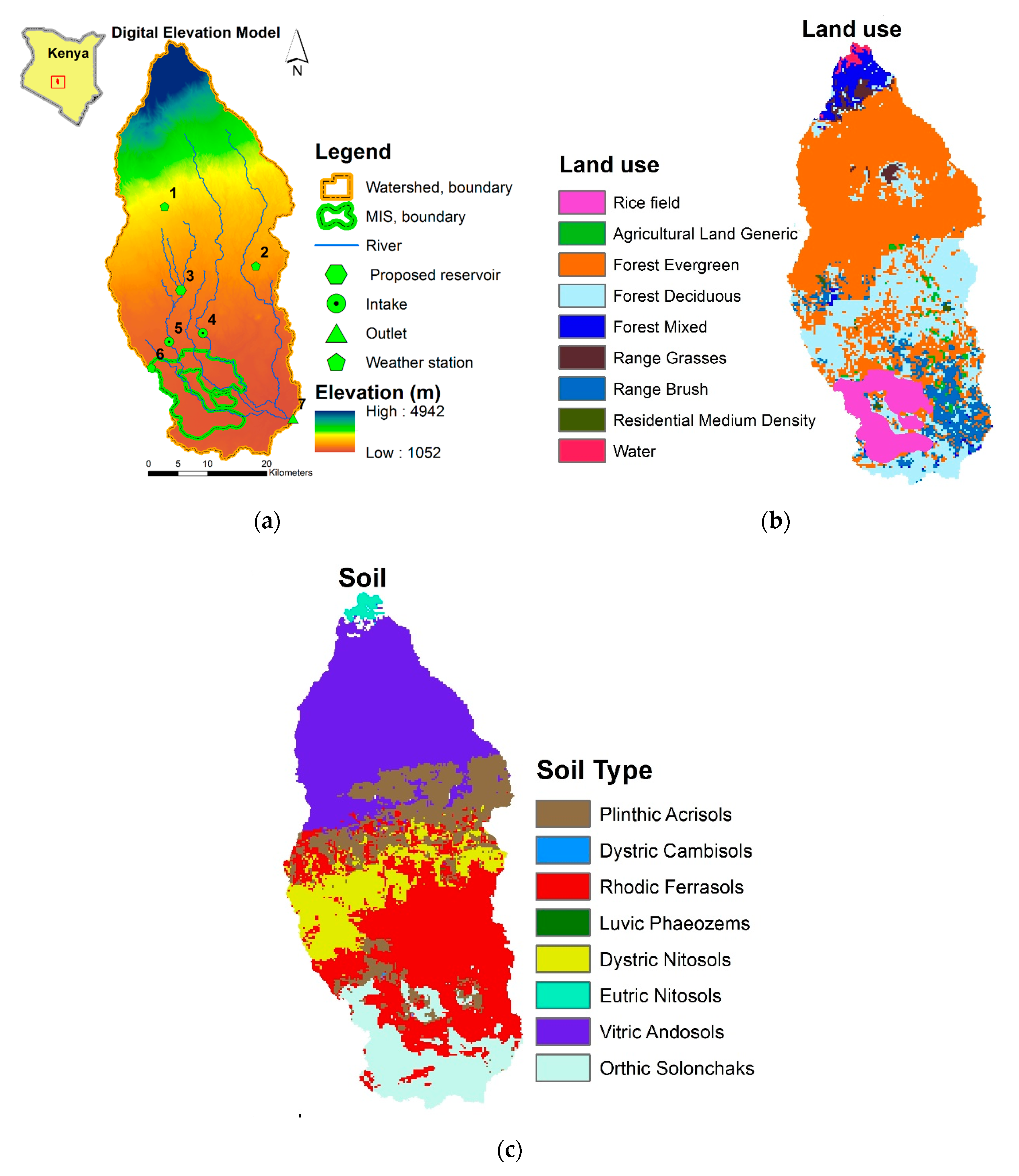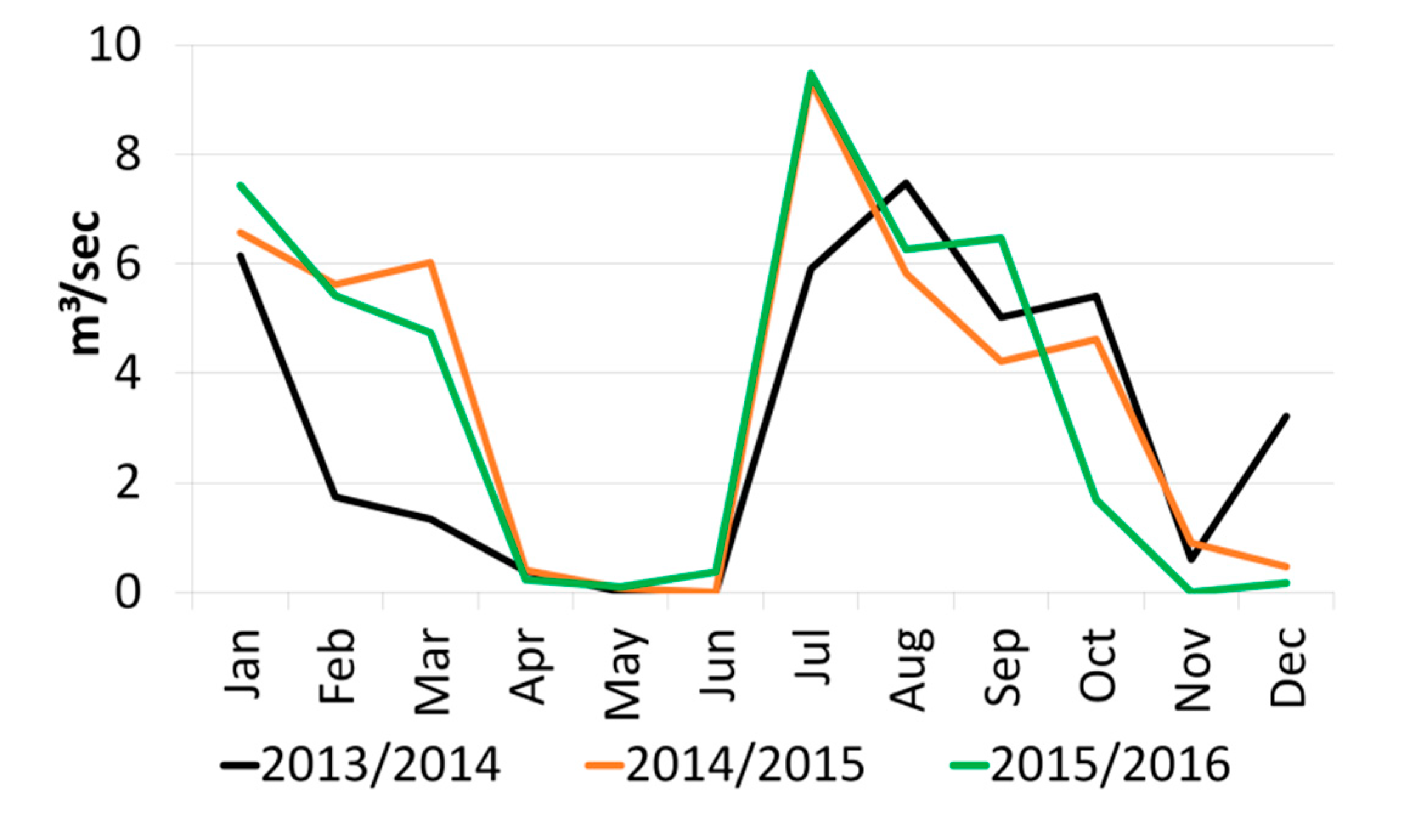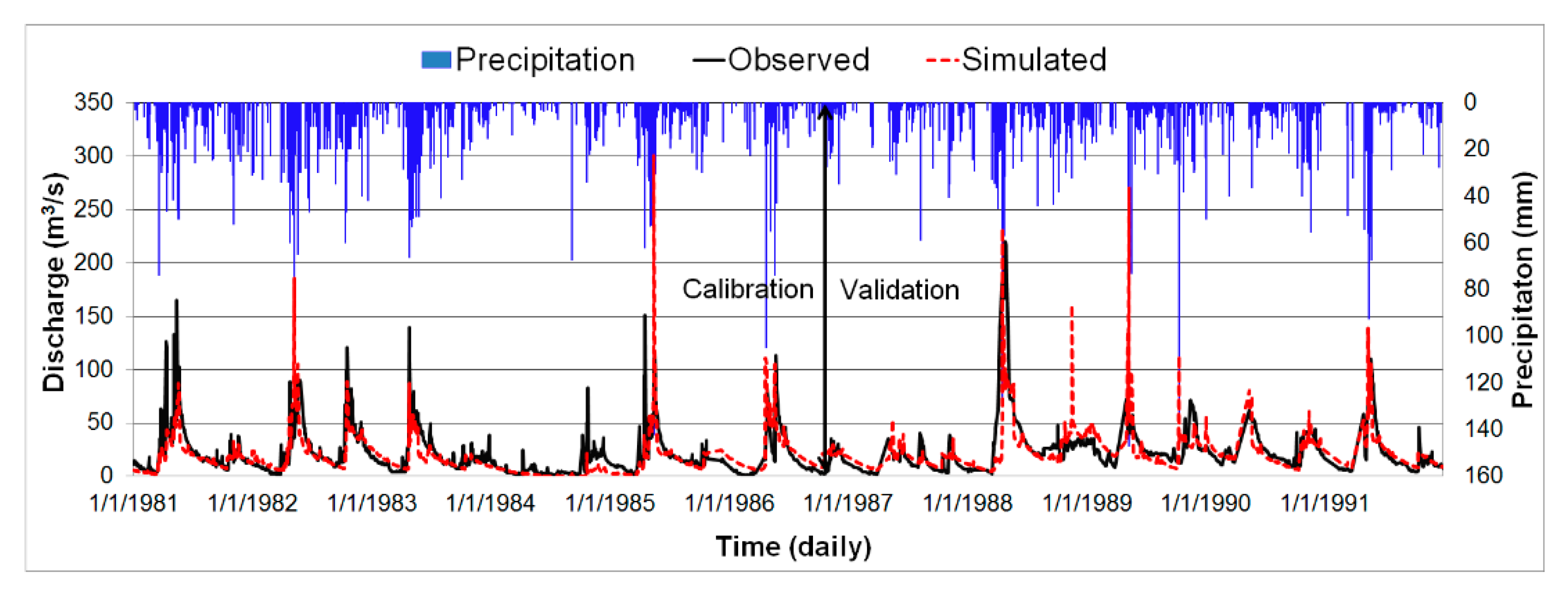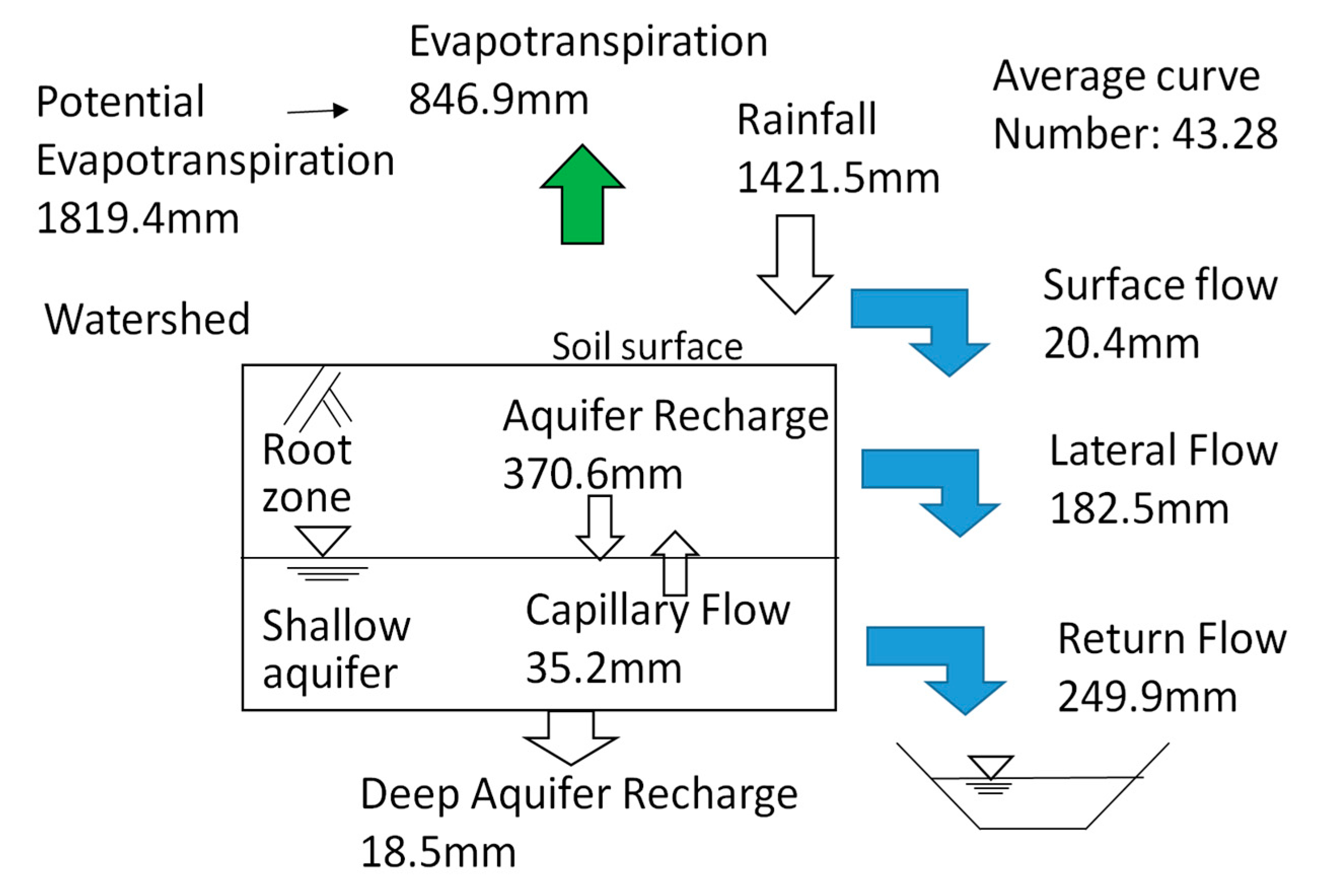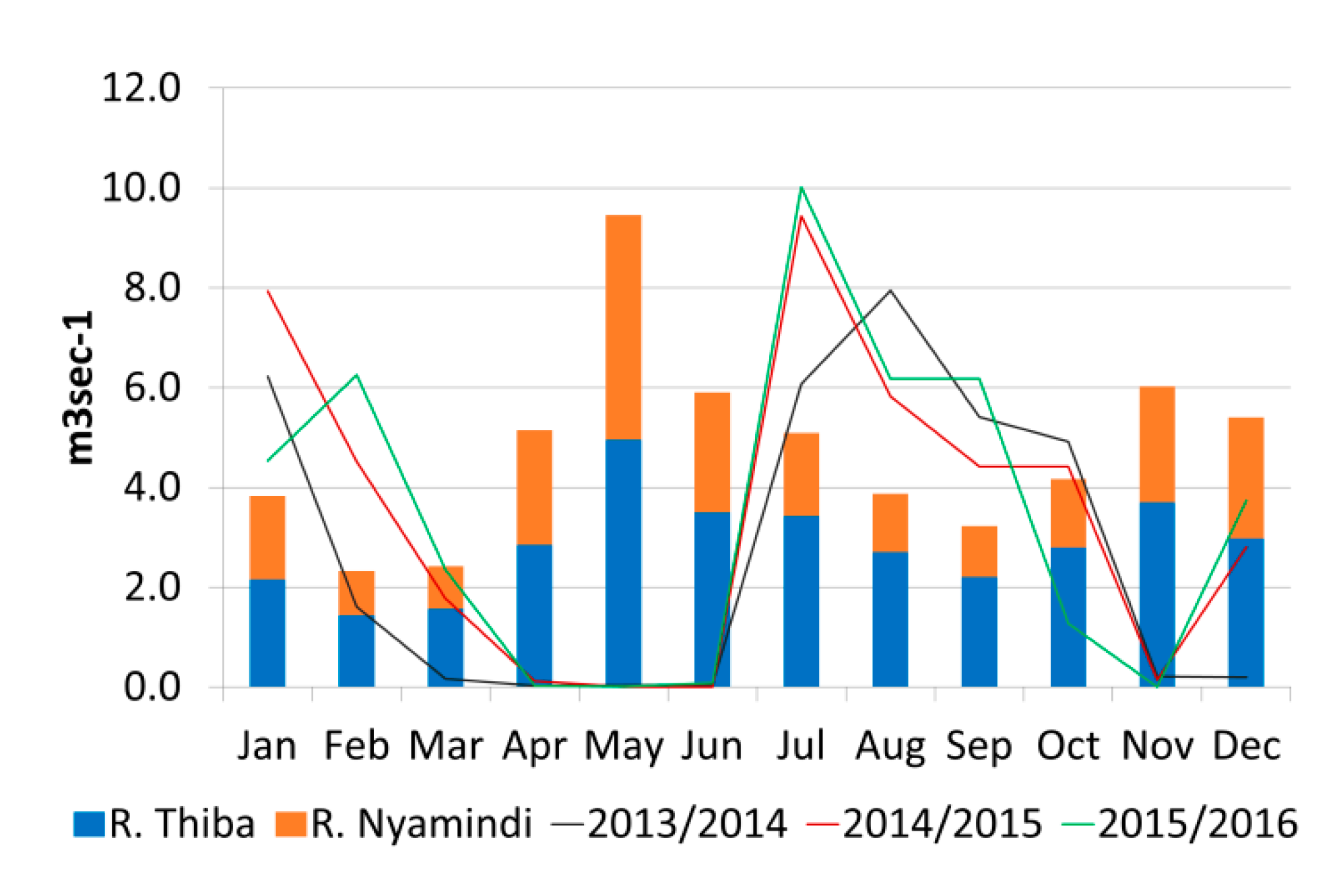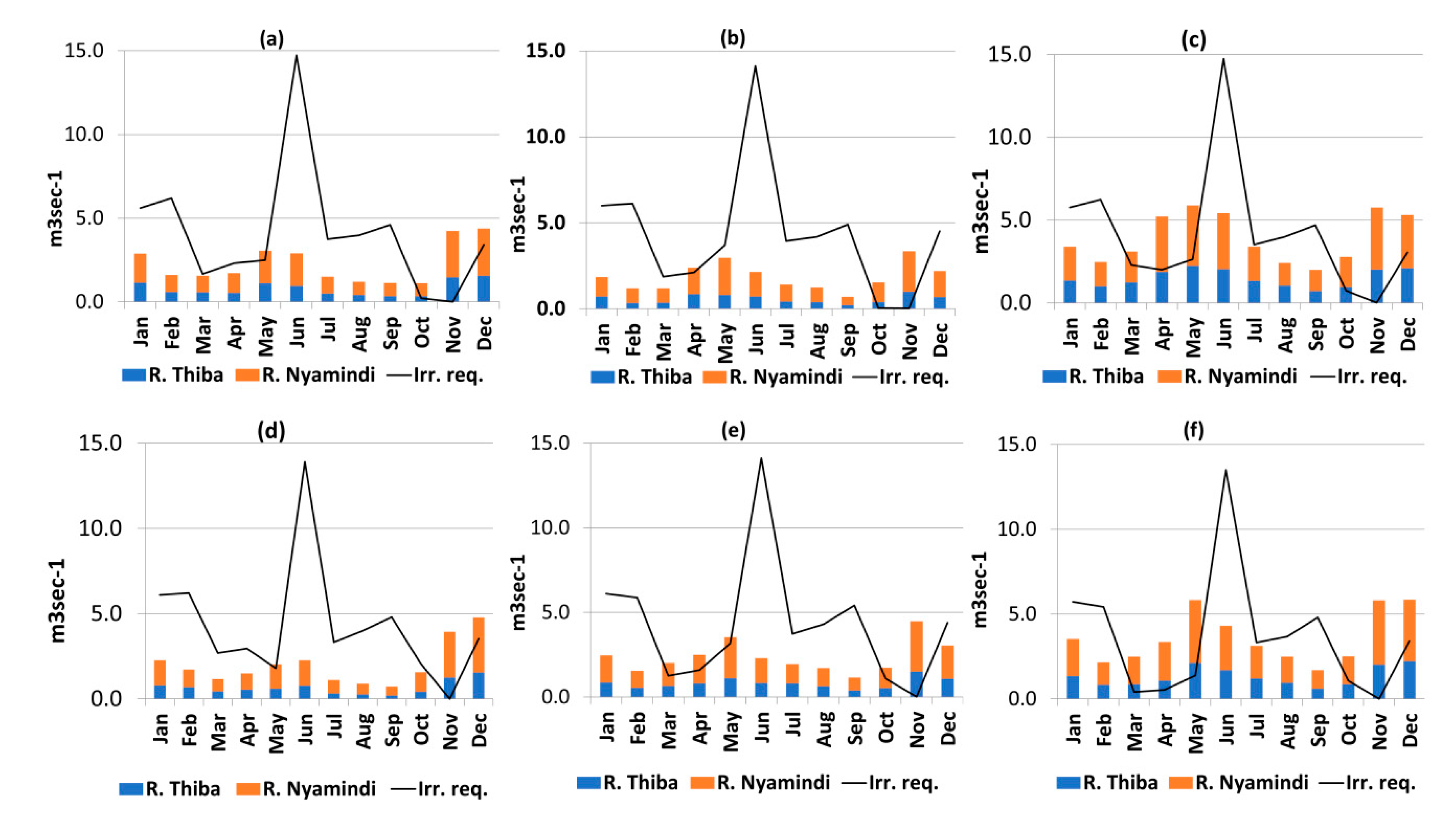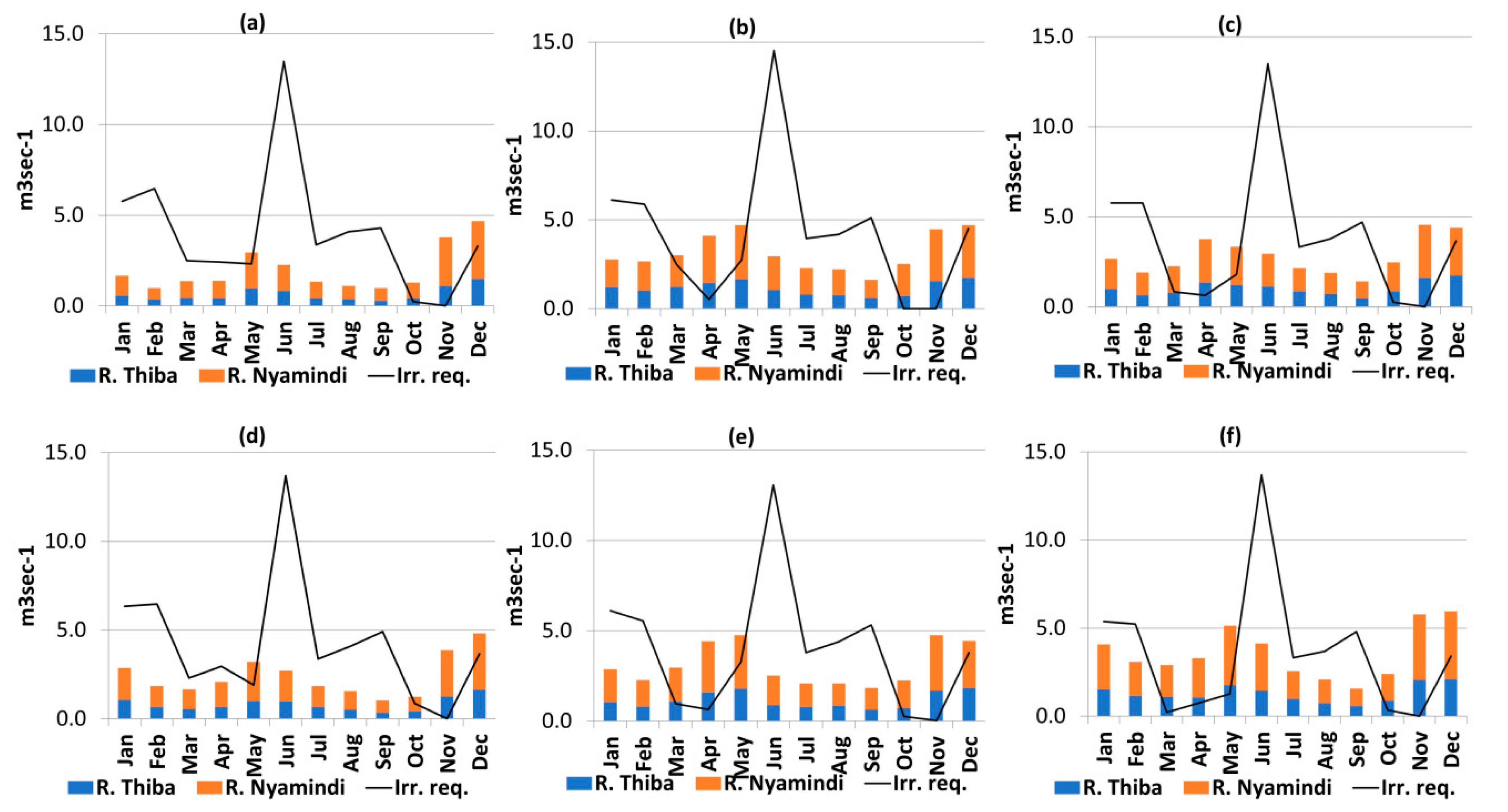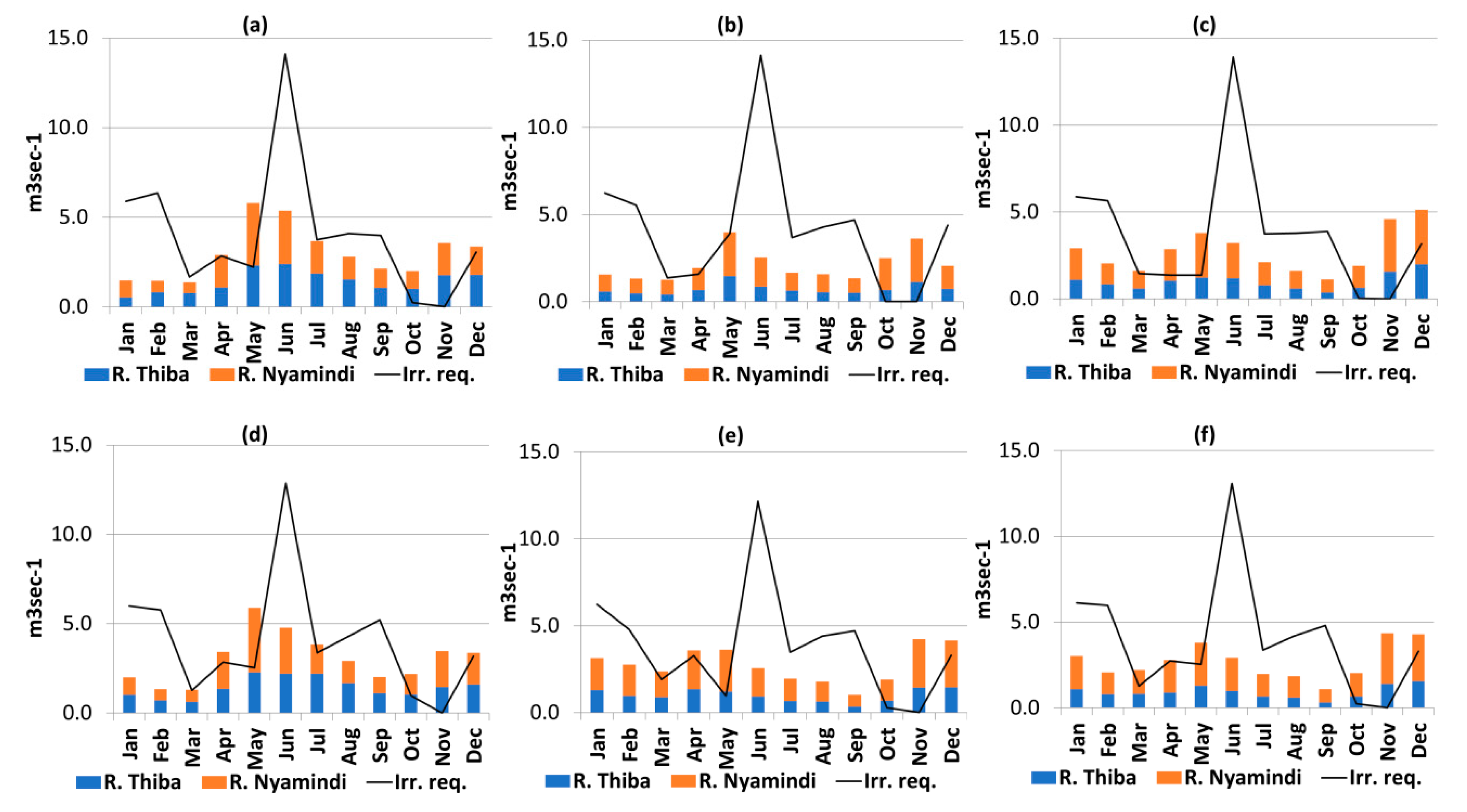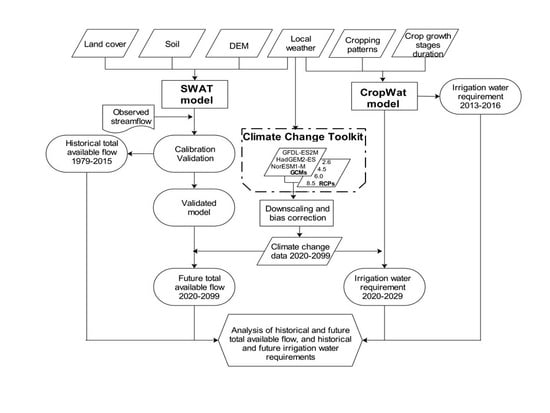1. Introduction
Rice is the most important staple food for more than half of the world’s population and it is grown by more than half of the world’s farmers [
1]. Irrigated rice accounts for 55% of the global harvested area and contributes about 75% of global rice production [
2]. Irrigation in Kenya is under the mandate of the National Irrigation Board (NIB). The Government of Kenya has put in place several irrigation projects aimed at stabilizing food security, which fall within the government’s development blueprint named Vision 2030 that seeks to make Kenya a newly industrialized middle-income country by the year 2030 [
3].
Rice in Kenya is mainly grown in the Mwea Irrigation Scheme, MIS. MIS is located about 100 km north of the capital city of Kenya, Nairobi, in the Upper Tana catchment, where rain-fed agriculture has increased rapidly over the last few decades and contributes to over 60% of land use [
4]. The scheme was established in the 1950s as a paddy production scheme to provide a means of food and livelihood to resettled landless people. MIS abstracts irrigation water from two rivers (River Thiba and River Nyamindi) and from two fixed weir intakes and conveys the water via gravity. MIS started with an initial 2000 hectares and currently has a total gazetted area of about 12,140 hectares. An increase in economic activities, population within and around the scheme and unplanned expansion of irrigation areas (mainly from 1999 to 2003) has led to an increased demand for the available water [
5]. The irrigation method at MIS is based on the practice of continuously flooding the paddy fields (basin irrigation). Due to the limited water availability, the farmers have been divided into three groups, which are organized in such a way that they receive irrigation water at different periods, such as land preparation and transplanting. NIB put in place plans to construct a predominantly irrigation water supply dam (the Thiba dam, which will be 40 m high with a storage capacity of about 11 million cubic meters), to be located on the River Thiba; it will increase the irrigable area in the future by over 2300 Hectares. However, the aforementioned dam (designed in 1996) has taken a long time to come to fruition, while water shortage problems continue to affect farmers.
Climate projections are available mainly from General Circulation Models (GCMs), which support the understanding of the global climate and projected changes in large-scale climate variables [
6,
7,
8]. The GCMs usually apply Representative Concentration Pathways (RCPs) for future climate modeling. RCPs are the product of an innovative collaboration between integrated assessment modelers, climate modelers, terrestrial ecosystem modelers and emission inventory experts [
9]. Water resources for rice production could be significantly affected over the next century due to global climate changes [
10]. In East Africa, climate change impact studies have largely been applied to weather changes, stream flow, groundwater and sediment yield studies [
11,
12,
13]. This case study provides a unique and more in-depth methodological approach. The future water supply is analyzed as total available flow and is compared against water demand that is analyzed as the irrigation water requirement at MIS. The comparisons, based on several GCMs and time periods, provide a deeper outlook of climate change modeling not only against stream flow/river discharge, but also against irrigation water demand. This study could contribute to more effective and adaptive planning measures in future developments of irrigation schemes and could help tap into the high irrigation potential of the East African region, even though this region faces significant challenges such as inadequate irrigation infrastructure, poor water management and an unreliable water supply [
14].
The Soil Water Assessment Tool (SWAT) model is a hydrological modeling tool that can be used to model and predict some of the hydrological processes. It was developed primarily to predict the impact of land management practices on water, sediment and agricultural chemical yields in large complex watersheds with different soil types, land use and management practices [
15]. The SWAT model was chosen because it has already been applied to water quantity and quality issues for a wide range of scales and environmental conditions globally, and is also comprehensively reviewed [
16,
17]. Potential impacts of future climate change were modeled using SWAT on the Nzoia catchment in the Lake Victoria Basin in Kenya to enhance the understanding of climate change scenarios on stream flow [
18]. Simulated current and future stream flows were assessed using SWAT to investigate major monthly stream flow changes in four watersheds in Mt Elgon, Kenya [
19].
CropWat is a computer program developed by the Land and Water Division of the Food and Agriculture Organization (FAO) for planning and management of irrigation. CropWat had been widely used in assessing crop water requirements, irrigation scheduling and cropping patterns [
20,
21,
22]. A comparison of CropWat among other similar models showed that CropWat was a better tool for estimating crop water requirements [
23]. It calculates crop water requirements and irrigation requirements based on soil, climate and crop data. In the absence of sufficient climatic data, supplemental data can be obtained from CLIMWAT, a climatic database used in combination with CropWat and which offers observed agro-climatic data of over 5000 stations worldwide. CLIMWAT is a joint publication of the Water Development and Management Unit and the Climate Change and Bioenergy Unit of the FAO.
Water resources can be described as blue water resources (e.g., fresh water from surface streams, reservoirs and groundwater), and green water (i.e., the precipitation that temporarily stays on vegetation or is stored in soil that eventually evapotranspirates back to the atmosphere [
24]). Given the fact that the economic and the ecological values of blue water and green water are different [
25,
26], a direct comparison of the green water availability index and blue water availability index may be inappropriate [
27] and confusing due to the wide range of indices that exist [
28]. Agricultural water use was often a focus of previous blue water scarcity studies, because irrigation consumption for agriculture composes about 80–90% of total blue water consumption [
29,
30]. In this study, the SWAT model analyzed the blue water aspect, i.e., the supply side, and CropWat analyzed the green water aspect, i.e., the demand side; water availability was referenced to an index for classifying Sub Saharan countries based on agricultural water demand and water resource supply [
31]. In the context of this study, water availability refers to the capacity of the irrigation water supply at MIS to be able to meet the irrigation water demand. The objective of this study is to evaluate current and future irrigation water resource availability for the improvement of planning and water management at MIS.
4. Discussion
4.1. Water Shortage Timing
The peak irrigation water requirements (in m
3 s
−1) were estimated to be between the months of July and August, which mainly fall within the land preparation period. Most of the farmers would prefer to transplant at the beginning of the short rain season and harvest between November and December when there is a high demand for rice due to the long Christmas holidays. However, they are required to follow the cropping calendar provided. Climatic conditions make planting in the long rain season (April–May) less favorable due to higher susceptibility to rice blast disease, which has been reported to cause about 60–70% of the yield losses [
64]. Since most of the farms are operated using family labor and they primarily rely on rice farming as their main source of income [
65], MIS management will have to ensure adequate water availability for the main rice crop to ensure farmers can harvest and sustain their livelihoods. The water shortage may be exacerbated by withdrawal of water from the main canals for other illegal uses, as observed during our field studies in 2018 and 2019. The withdrawals observed included use of water for domestic use at home and for running small car wash businesses along major roads within the scheme. Such withdrawals are difficult to quantify and were not considered in this study.
Previous studies indicated that horticultural farms located upstream of MIS abstract water from the River Thiba and the River Nyamindi, thus contributing to a reduction in the water available for the scheme. A survey conducted in 1997 indicated that about 10% of the abstractions were legal [
40]. The MIS management can put forward proposals to the relevant government authorities for more stringent policies that could be used to monitor and control water abstraction in rivers and to protect the MIS farmers against water shortages. In addition, local community sensitization on the importance of irrigation water could also play a role in community policing and monitoring of illegal water abstractions. The extent of water shortage for irrigation can also be used by the relevant government authorities (such as the Water Resources Authority, Kenya) in guiding/controlling the issuance of permits for abstraction of water for other purposes. This could play an important role in increasing water availability for irrigation.
4.2. Impact of Climate Change
Across the two periods analyzed for all GCMs, the highest future water deficits were estimated to be in the months of June, representing a shift from the month of July as observed in 2013–2016. Under the proposed cropping program (that is supposed to used after the dam construction), the main rice crop will heavily rely on irrigation water from the dam throughout its growth stages from transplanting to harvesting. This is because the main rice crop falls between the periods of July to October. This period was observed to have a strong predominance of water deficits across all GCM simulations. Water stored in the dam after the long rains (April/May) should be carefully released for the main rice crop mainly during land preparation and transplanting in the months of June and July. A decrease in the amount of long rains would have an impact on the main rice crop. Future farming practices should take into consideration the water availability in the high water deficit months and explore the options of reducing the water deficits such as practicing more efficient rice irrigation methods.
There have been initiatives to introduce water-saving irrigation practices at MIS over the years, most notably in the Rice-Based and Market-Oriented Agriculture Promotion Project (RiceMAPP) in demonstration farms [
66]. Such initiatives take into consideration water-saving practices as a way of reducing water use, and the larger aspect of climate change would require adequate sensitization and training of farmers in order for them to be successfully implemented. A previous study on the socio-economic status of farmers at MIS conducted in 2013 indicated that about 43% of small-scale farmers at MIS had completed a high school education. Increased government efforts in raising the education level of farmers could contribute to better sensitization, learning and training of farmers on new and better water-saving technologies, promote a strong participatory approach, and contribute to combating the impacts of climate change. Such water-saving initiatives could be taken into strong consideration and could contribute to a reduction of the high peak water demands compared to the current conventional flooding irrigation methods.
4.3. Adaptation of Cropping Pattern
Under the proposed cropping pattern, the total land area under irrigation is 17,900 ha for the long and short rains upland crops; and short rain rice and ratoon rice. In the existing cropping pattern, the land areas under irrigation for the 2013/2014, 2014/2015 and 2015/2016 seasons were 7890 ha, 8095 ha and 8903 ha respectively. With the expected increase in land area under irrigation and the introduction of new upland crops, farmers will have to adapt to water management, particularly in the months with high water deficits.
The proposed short rain upland crops fall within the months of October and January. The months of November and December were evaluated to have surplus irrigation water in the future period. With careful management of dam irrigation water, MIS management can explore the opportunity for utilizing the surplus water. Cropping intensities for the short rain upland crops could be increased to make use of the surplus water, hence improving production in the future.
The month of February, which falls at the beginning of the long rain upland crops in the proposed cropping pattern, was observed to have the second highest irrigation water deficit. Farmers will predominantly rely on irrigation water during the planting stage. MIS management should plan for careful management of the dam irrigation water and ensure that irrigation water is available during this important time for the long rain upland crops. The mid-season stage for the upland crops falls during the long rain season (April/May) when surplus irrigation water was observed to be available. The methodological approach presented in this study could be adopted for guiding the development of cropping patterns within the East African region to tap into the irrigation potential. Identification of projected water shortages and surplus months can play an important role for farmers in increasing their efficiency and productivity.
5. Conclusions
This study’s objective was achieved through applying a SWAT model to estimate the current and future water resources (as total available flow) and CropWat to estimate irrigation water requirements. Downloaded, spatially interpolated, downscaled and bias-corrected future climate data from a Climate Change Toolkit were input into SWAT and CropWat to simulate future scenarios. The future climate data was also input into CropWat to analyze future irrigation water requirements. The results show that the highest irrigation water deficits will be experienced in the month of June. The months of July–October and January–February are also expected to have deficits. Surplus irrigation water is expected to be observed in the months of November and December in the future. The results could be useful to MIS in estimation of water availability, addressing climate change impacts through a participatory approach with farmers and the government, developing cropping patterns and an overall improvement of planning and water management at MIS. This study aspires to contribute to water availability research by presenting a methodological framework for current and future water resource availability for irrigation planning and management in regions where data availability may be inadequate but there exists a future irrigation development potential.
A major limitation in this study was the lack of data for calibrating the CropWat estimations. With due attention to this limitation, findings of this study can be used for the improvement of irrigation water resource planning and management. In the future, after the implementation of a dam on the River Thiba, data monitoring in dam release, stream flow, sediment in the river (and in the reservoir) and canal flows should be conducted for future modeling of the Thiba dam and MIS. This would allow for analysis such as future dam irrigation water supply and sediment inflow into the reservoir to estimate future maintenance/dredging costs. Data monitoring on irrigation water quality, irrigation conveyance and drainage canals should be conducted to monitor any water losses. Also, strong considerations should be made for conducting soil tests at MIS watershed area. The soil data could be very useful in SWAT simulations as well as in CropWat data input in order to reduce the bias in the estimations of total available flow and irrigation water requirements.
